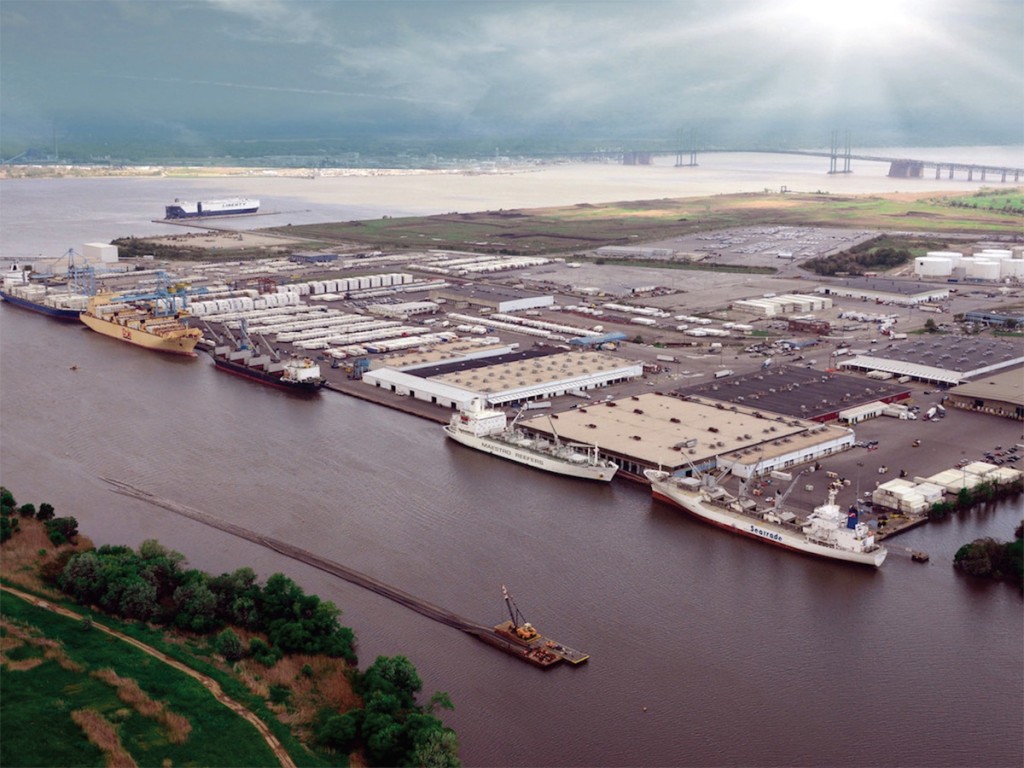As the Port of Wilmington celebrates its centennial anniversary, Joe Cruise, CEO, GT USA Wilmington, also applauds the Delaware seaport’s recent success and plans for vast future expansion.
In a written response to questions from the American Journal of Transportation, Cruise noted Feb. 14 that the growth achieved by the Port of Wilmington in 2022 has continued into 2023. GT USA Wilmington (GTW), which operates the port, “is confident of continuing the successes of last year. 2022 turned out to be a very successful year for The Port of Wilmington. Revenue showed a 19% increase while cargo tonnage throughput increased by 24% over 2021.”

Edgemoor Site Terminal Construction
As to the 100th year since the port opened its gates and commenced cargo operations, Cruise observes that it’s not only volumes that have enormously escalated. “It is also interesting to note the changes in the types of cargo coming through the port. Early cargoes consisted of lumber, wood pulp, quebracho logs, cork, jute, burlap, lead, ilmenite ore, fertilizer, and petroleum products. Lumber and petroleum products still feature significantly, but now fresh fruits dominate.”
For inbound ships arriving from Delaware Bay, the Port of Wilmington is the first major port on the Delaware River and not only a key port of entry but distribution center for year-round cargo of bananas and pineapples, seasonal importation of fresh Moroccan citrus and Chilean grapes, along with other fruits and juices from around the globe. Cruise notes that the port boasts a one-million square foot on-dock warehouse complex and is one of North America’s largest facilities that serves as a refrigerated distribution hub for the United States and Canada.
South American fresh produce continues to be a mainstay at Wilmington, with grapes, peaches, plums, cherries, avocados and citrus from Chile, apples and pears from Argentina, fruit concentrate from Brazil, grapes and citrus from Peru and bananas from Colombia and Ecuador. Cruise indicates that continuing the fruit season through the summer months remains a priority for GT USA Wilmington. This began during the 2022 summer with several vessels and hope to grow this business during 2023.
Beyond fresh produce, the port handles diverse cargoes, including containers, dry and refrigerated breakbulk and dry and liquid bulk; salt, petcoke, grains, new and used vehicles and heavy equipment, live cattle, space components, wind blades, and much more. Forest products are a fast expanding cargo for the Port of Wilmington. Lumber, in particular, has had a strong start to the year, with the Port receiving three vessels in January alone.
“Many ports are still dealing with congestion issues, but the improvements we have made at the Port of Wilmington are allowing us to continue our planned growth,” said Cruise. “This is such a diverse port, with great facilities, new equipment and with the cargo handling expertise of our ILA partners, we will continue to seize upon opportunities to attract new business,” Cruise indicated to AJOT.
“We continue to work hard with the assistance of all our partners to fulfill the potential of this great Port. The infrastructure improvements that have been made in recent years are helping us to provide increased services to all our customers, as well as to attract new customers, and we will continue building on those improvements. “We have a hard-working work force that is quite flexible and, with the upgrades to the forklift fleet, yard truck fleet, and all electric RTGs they are even more productive,” said Joe Cruise. “GT USA Wilmington aims to pay a fitting tribute to everything the Port of Wilmington has achieved throughout its 100 years.”
Celebratory events are being planned for later in the year and details of these will be released shortly.
When the Port of Wilmington first opened in 1923, it stood on 105 acres. Now it occupies 308 acres. Initially, its warehouse storage was 120,000 square feet. As mentioned above, that figure now exceeds one million. Wilmington’s original berthing area of 1,210 feet is now over 4,500 feet. According to Cruise, in the terminal’s first year it handled 17,000 tons of cargo and today the port handles over six million tons.
Partnerships with these countries go back a long way in Wilmington’s history and they remain strong to this day. In early February, Cruise attended a breakfast at the Chilean Ambassador’s residence in Washington, DC to commemorate 200 years of diplomatic relations between our countries and the Argentinian Minister for Trade visited the Port to reaffirm the relationship with the Port of Wilmington.




